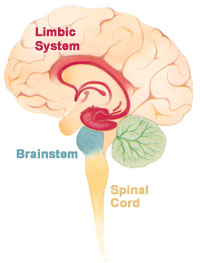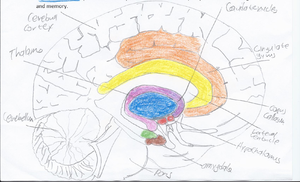Limbic System
From WikiLectures
The limbic system is a group of structures localised in the forebrain and the hypothalamus. It is named after the Latin term limbus which means border; this is because the limbic system exists as the border of the cortex.
The limbic system is responsible for all emotions humans exhibit, instincts, drives and also is responsible for learning skills and memory.
Components of the Limbic System[edit | edit source]
- Cortical Components (Limbic Lobe):
- Orbital Frontal Cortex: Involved in perceiving smells and plays a role in memory formation.
- Hippocampus: Associated with long-term memory.The hippocampal formation is a compound structure that forms a c-shaped bulge on the floor of the temporal horn of the lateral ventricle in the medial temporal lobe of the brain. It includes the dentate gyrus, the hippocampus proper, subiculum, presubiculum, parasubiculum, and entorhinal cortex. It is involved in the Papez loop where impulses from the hypothalamus travel to the anterior thalamus and then from the cingulate gyrus through the hippocampus back to the hypothalamus. It is responsible for spatial navigation, attention control and recalling of the short term and long term memory.
- Insular Cortex: Linked to desires, cravings, and addiction.
- Cingulate Gyrus: Perceives neuropathic pain and nociception. Connects limbic system and cerebral cortex
- Parahippocampal Gyrus: Provides a communication pathway between cortical association areas and the hippocampus.
- Subcortical Components:
- Amygdala: this connects the olfactory bulb and the cortex to the rest of limbic system. Responsible for fear and anxiety responses.
- Olfactory Bulb: Receives olfactory input related to smells detected in the nasal cavity.
- Hypothalamus: Acts as the final output hub of the limbic system. Connects vision and auditory senses to limbic system. It is responsible for linking nervous system with the endocrine system.
- Anterior and Dorsomedial Nuclei of the Thalamus: Collaborate with the limbic lobe. Connects limbic system and cerebral cortex; responsible for learning and memory.
- Functional Aspects (“Five F’s”):
- Feeding: Regulates satiety and hunger.
- Forgetting: Involves memory processes.
- Fighting: Influences emotional responses.
- Family: Relates to sexual reproduction and maternal instincts.
- Fornicating: Tied to sexual arousal.
Clinical Relations[edit | edit source]
- Amygdala Lesions: Can lead to fear-related disturbances.
- Anterograde Amnesia: Inability to form new memories
Links[edit | edit source]
Bibliography[edit | edit source]
- KAPIT, W. The Physiology Coloring Book. 2nd edition. 1999. ISBN 0-321-03663-8.
- FITZGERALD, M.J. Turlough. Clinical neuroanatomy and neuroscience. 6th edition. 2012. ISBN 978-0-7020-3738-2.
- https://nba.uth.tmc.edu/neuroscience - Limbic system:Hippocampus - Chapter 5, Anthony Wright. Neuroscience online electronic book. Last revised 10/10/2020. Accessed on 07/05/2024.



